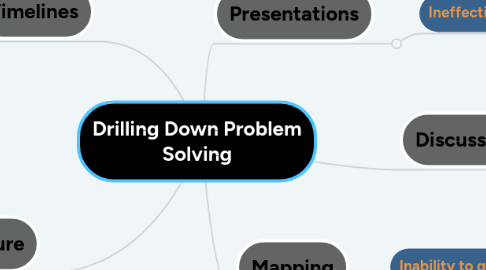
1. Lecture
1.1. Out of town on class date
1.1.1. Out of town for next three days
1.1.1.1. Does not want to cancel class
1.1.1.2. Would like to try new technology but does not know how
1.1.1.2.1. Needs help to do so
1.1.1.2.2. No training available
1.1.1.3. Wants to utilize online resources to keep up with structure of class
1.1.1.3.1. Discussions
1.1.1.3.2. Quizzes
1.1.1.3.3. Reports
1.1.2. Info
1.1.2.1. Older Gentlemen
1.1.2.2. Part-time Teacher
1.1.2.3. Investor
1.1.2.4. Inexperience/Nervous about using technology
1.1.2.5. Graduate Level Business Class in Leadership
1.1.2.6. Apprehensive of using other people's resources to teach
1.1.3. Questions
1.1.3.1. Can there be a live discussion during that class time?
1.1.3.2. What type of activities can be done via online class?
1.1.3.3. What type of assessments can I create using online resources?
1.1.3.4. I have a video I want to show to the class. What can i do with it?
2. Timelines
2.1. Misunderstanding of events
2.1.1. Reasons
2.1.1.1. Too much information is being thrown into the mix.
2.1.1.2. Difficult to answer "why" questions with
2.1.1.3. Usually only key words of phrases to an event, no details
2.1.1.4. More of a relay of information, rather than conceptual grasping.
2.1.1.5. Basic text, information filled tools that don't grab the readers attention.
2.1.2. Info
2.1.2.1. Easy to see cause and effect of events.
2.1.2.2. Visual chronological tool to help students see events over time.
2.1.2.3. Effective way of displaying major events.
2.1.2.4. Great study guides to review before assessments.
2.1.3. Questions
2.1.3.1. How can we use timelines to help students really connect events together instead of being overwhelmed with information?
2.1.3.2. Are there ways to make a timeline more interesting, interactive, or applicable?
2.1.3.3. Can educatots use media effectively in timelines, so that students can relate to it?
2.1.3.4. Are there ways to add information into the timeline so that it is not just major events or dates?
3. Presentations
3.1. Ineffective Learning
3.1.1. Reasons of ineffectiveness of class
3.1.1.1. Boring Lessons
3.1.1.2. Non-engaging professor
3.1.1.3. Hard to relate/follow along with
3.1.1.4. Poor utilization of time
3.1.1.5. Difficult Subject
3.1.1.6. Needs scaffolding and modifications to material
3.1.1.7. No teacher/student relationship
3.1.1.8. Students checking out/uninterested
3.1.2. Info
3.1.2.1. Lecture class
3.1.2.2. Students only listen
3.1.2.3. Boring powerpoint presentation (No images/videos)
3.1.2.4. No collaboration/groups
3.1.2.5. Teacher Centric Couse (no student engagement)
3.1.2.6. Very large class number
3.1.3. Questions
3.1.3.1. Is there any scaffolding or Problem Based Learning or Blended Learning being inserted?
3.1.3.2. Can we add in videos or images or demonstrations to the lesson to bring the students to life?
3.1.3.3. Does teacher assign pre-class reading on material so that students have prior knowledge?
3.1.3.4. Can we add an interactive activity or use technology to help students follow along with the notes during class? (i.e. a synced app for class fill in the blanks or ask questions during the lecture)
3.1.3.5. Are there clear progress checkpoints or expectations to help the student follow along?
3.1.3.6. Can we utilize any blended learning techniques to add relatable examples to the material covered?
3.1.3.7. Is there any scaffolding that can be done to help the students who may not be masters in chemistry succeed and be interested?
4. Discussions
4.1. Online Discussions
4.1.1. Lack of Effectiveness/ Prescence/ Content
4.1.1.1. Reasons
4.1.1.1.1. Lack of social perspective
4.1.1.1.2. Assignment seems unimportant
4.1.1.2. Info
4.1.1.2.1. Time to prepare resonses
4.1.1.2.2. Responses do not get read/noticed
4.1.1.2.3. Low student interaction
4.1.1.2.4. More accessible for students in modern society
4.1.1.2.5. Available for collaboration with students outside of class
4.1.1.2.6. Longer/lengthy responses
4.1.1.3. Questions
4.1.1.3.1. What type of prompts can be used to keep students on-task and prepared?
4.1.1.3.2. Are students really understanding the material?
4.1.1.3.3. How do we assess through online discussions?
4.2. F2F Discussion
4.2.1. Lack of Effectiveness/ Presence/ Content
4.2.1.1. Reasons
4.2.1.1.1. Lack of participation from some students
4.2.1.1.2. Certain students dominate discussion
4.2.1.1.3. Detachment from class
4.2.1.1.4. Sometimes get off topic
4.2.1.1.5. Possibility for inappropriate comments
4.2.1.1.6. Some unprepared for the discussion
4.2.1.2. Info
4.2.1.2.1. Fast Paced
4.2.1.2.2. High Energy
4.2.1.2.3. Enables immediate reaction
4.2.1.2.4. Conversation flow
4.2.1.2.5. Visual cues available for reaction
4.2.1.2.6. Quicker/more direct responses
4.2.1.2.7. Improper conversation etiquette
4.2.1.3. Questions
4.2.1.3.1. How can we get more students involved?
4.2.1.3.2. What type of lessons can create the best discussions?
4.2.1.3.3. What prompts should be made?
4.2.1.3.4. How do we get more students to participate?
5. Mapping
5.1. Inability to grasp concepts
5.1.1. Reasons
5.1.1.1. Cannot see the connection between points
5.1.1.2. Difficult to see relationship between information
5.1.1.3. Lose cause and effect factor
5.1.1.4. Students lose the grasp of material early, but lesson moves forward, increasing confusion.
5.1.2. Info
5.1.2.1. Concept Mapping provides a visual representation for learning.
5.1.2.2. Enhances critical thinking by forcing students to understand concepts rather tan just facts.
5.1.2.3. Easy to participate in.
5.1.2.4. Can be used as study guides/review sheets.
5.1.2.5. Can be a continuous project and expanded upon by others.
5.1.2.6. Easy to determine areas of misunderstanding.
5.1.3. Questions
5.1.3.1. How can a concept map provide the necessary information in a conceptual way?
5.1.3.2. Will students be able to filter the important information?
5.1.3.3. How can we assess the map?
5.1.3.4. Is this a technological accessible resource for everyone?
5.1.3.5. Can students work together on these maps?

